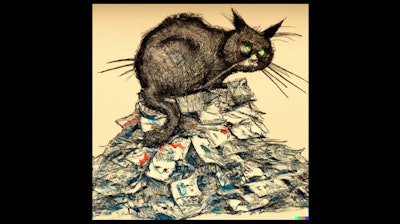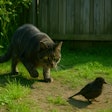
Concern trolling influences pet food trends both from within the industry and without. Concern trolling involves feigned concern about a particular issue or topic, while actually attempting to undermine or provoke others. Concern trolling distracts people from real treats by setting up a scary paper tiger. Fear of fluoride in public water supplies provides an ideal example of concern trolling, as discussed in an article on Big Think. The health problems presented by cavities and bone fractures far outweigh the dangers of fluoride. Yet some communities still reject adding the element to their drinking water because of conspiracy theories, like those held by General Ripper in the film “Dr. Strangelove.” Fluoride doesn’t threaten our precious bodily fluids or make people more susceptible to Communist plots, as the antagonist of that Stanley Kubrick film ranted. It does strengthen people’s teeth and bones though. More recently, concern trolls have focused on vaccines, especially during the now-endemic COVID-19 pandemic. Far more people have died of COVID-19 and other diseases than from the vaccines that can prevent these illnesses. Concern trolls also have focused on genetically modified organisms (GMOs), such as vitamin-A-enriched golden rice, without evidence that GMOs are harmful. In the case of vitamin-enriched rice, the rejection of GMOs removed a means for reducing the thousands of deaths and cases of blindness caused by vitamin A deficiency annually. GMO-free labeling claims appear on pet foods too, and the pet food industry has experienced various other forms of concern trolling.
Dr. Sustainabilitylove: Or How I Learned to Stop Worrying and Love the By-Products
In the pet food arena, concern trolls have created numerous documentaries, books, blogs and other online media to stoke fear of fillers, toxins, by-products and low-quality ingredients. Some have raised concerns that dogs and cats may themselves be rendered into pet food. Often these fear-mongers present themselves as consumer watchdogs, and some of them genuinely do believe that they are watching out for dogs, cats and other pets. However, there’s a difference between speaking truth to power and stirring up unfounded concern. When empirical evidence doesn’t support an opinion, but an individual ignores that evidence and continues spreading misinformation, that person has become a troll.
Perhaps worse than concern trolling by the public are those trolls that work within the industry as they market and advertise pet foods. Some pet food companies villainize aspects of the industry to make their own products seem like a better choice. How many pet food companies use the origin story claiming that their founder simply couldn’t find a healthy diet for their pet, so they decided to make their own? While that may be true for some pet food start-ups, the repetition of that story creates its own conundrum. When there are 10 different companies all claiming to be the original and first company to truly care about pet nutrition, why didn’t the founder of the 11th simply buy one of the pet foods made by the other 10? Ultimately, these marketing efforts use concern trolling to sow doubt in consumers’ minds about other brands. Concern trolls try to sound well-intentioned to gain credibility and appear reasonable, but instead they sow doubt, provoke controversy or muddle discussions. The goal of pet food makers is to provide pets with the nutrients they need to thrive, but companies undercut each other with their marketing messages and distract consumers from that ultimate goal of feeding healthy food to pets. Instead, human trends and fears get projected onto pet food, while legitimate concerns are overlooked. By-products provide a good example of this.
"What is in a name?" Romeo Montague asked, "A rose by any other name would still smell sweet." However, if they were called stench blossoms people would think of them differently, as Bart Simpson noted. The same can be said for upcycled pet food ingredients compared to by-products. The difference between pet foods made from by-products versus upcycled ingredients largely comes down to semantics. In a 2021 paper in the journal Foods, scientists proposed defining upcycled ingredients as environmentally friendly foods containing safe ingredients that otherwise would not have gone to human consumption, including damaged food produce, by-products and scraps from food preparation.
“By-products are what’s left over after the intended products are made — regardless of whether it’s in a food and beverage supply chain or a pet food supply chain,” Angie Crone, CEO of the Upcycled Food Association said in an email to Petfood Industry. “It’s these by-products that contribute to millions of pounds of food waste each year. Upcycling involves converting these food by-products into a new ingredient or edible food product through value-added processing, essentially allowing our food system to get more out of less. For example, instead of just one product from a manufacturing process, you can now get two!”
While by-products are disparaged by some pet food marketers, other companies rebrand by-products as upcycled. By either name, making use of otherwise wasted products benefits the economy and the environment. Ecological degradation endangers people and their pets far more than poultry meal, but concern trolling makes the lesser threat seem greater. While it's good that people are concerned about the quality of their pets' food, wasting resources is one human trend that benefits no one.
Fear and loathing of gluten and grain in pet food
Gluten-free pet foods are another example of human food trends entering the pet food industry via concern trolling. While people with celiac disease and similar maladies need to avoid gluten, celiac disease has never been diagnosed in dogs and cats. Sensitivity to gluten in pets are very rare, such as in a single family of Irish Setters documented in the Canadian Veterinary Journal. Despite a lack of evidence, pet food companies advertise their products as gluten-free, implying that it’s a good thing.
“Gluten-free claims on pet food labels became popular as a result of the success of similar claims on human food labels, though it is unlikely that many consumers completely understand the concept,” David A. Dzanis, DVM, Ph.D., wrote nearly a decade ago in his Petfood Industry column. “Regardless of any potential misconceptions, many people consider gluten-free to be a healthful notion, for them and for their pets. The fact that wheat gluten was wrongly accused as the cause of the melamine contamination of pet foods in 2007 (when, in fact, it was wheat flour adulterated to test as gluten) certainly added to petfood purchasers' concerns regarding anything to do with any source of gluten.”
Similarly, the grain-free trend often has relied on concern trolling advertisements that take advantage of pet owners fears and confusion about what is truly healthy for a dog or cat.
“Grain-free claims began to appear on pet food labels mostly as a euphemism for low-carb,” Dzanis wrote. “Because AAFCO policy effectively disallows claims regarding carbohydrate content, a means to convey the concept by implicating grains as the culprits facilitated the popularity of this niche. Of course, many of the replacement ingredients for grains (e.g., potatoes, sweet potatoes, tapioca, legumes) can also be high in starches, which muted this purported benefit. Still, the perception of grains as a negative took hold, with some espousing other potential benefits of a grain-free feeding regimen (e.g., more natural, avoidance of mycotoxins). Rightly or wrongly, many pet food purchasers now consider this aspect to be an important factor in their buying decisions.”
Contrary to some marketing messages, grains and the carbohydrates they contain can play an important role in dog and cat nutrition, even though cats are obligate carnivores.
“Similar to humans, there is a mandatory requirement for glucose in organs such as the brain in the dog,” Ryan Yamka, Ph.D. wrote in his Petfood Industry blog. “As a result, when dietary glucose (i.e., starch) is not supplied in the diet, the dog’s body will utilize amino acids and glycerol to synthesize glucose via gluconeogenesis. Additionally, cats are always in a state of gluconeogenesis, indicating that glucose is important for normal metabolism as well and is why cats do need higher protein diets. Although, it is important to point out that cats do not utilize carbohydrates as rapidly as dogs. If it is not supplied in the food, it will be made internally (assuming they have the proper building blocks). Thus, carbohydrates are good for both dogs and cats and are necessary for survival.”
Carbohydrates provide one example of how concern trolling has shaped the pet food industry. Controlled experiments have provided evidence of how grain products affect dog and cat health, but some pet food marketers choose to ignore this data and spread false concerns in order to sell their products. What other examples of concern trolling exist in the pet food industry?

















